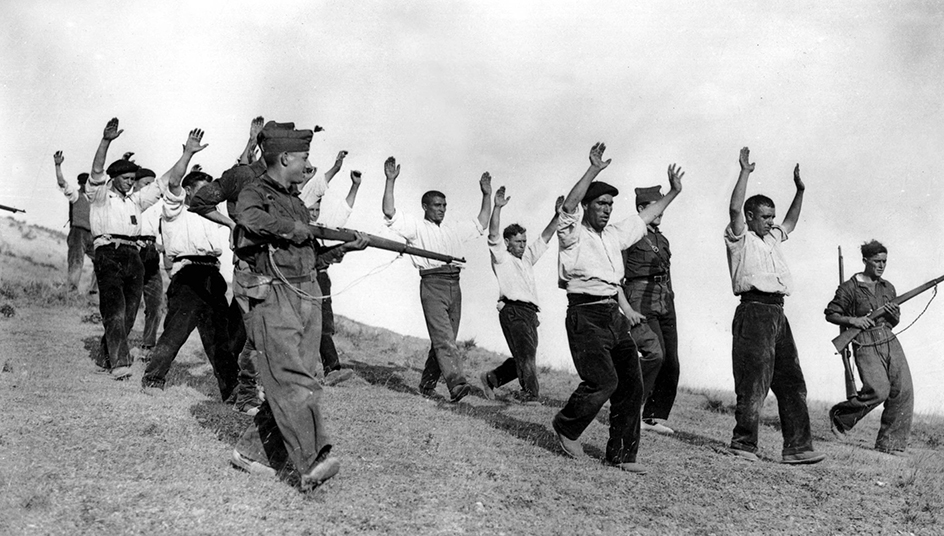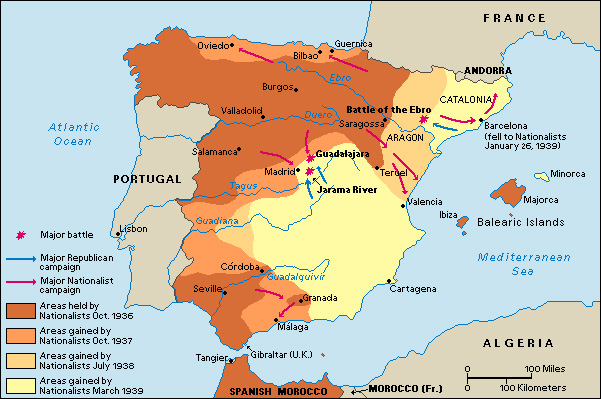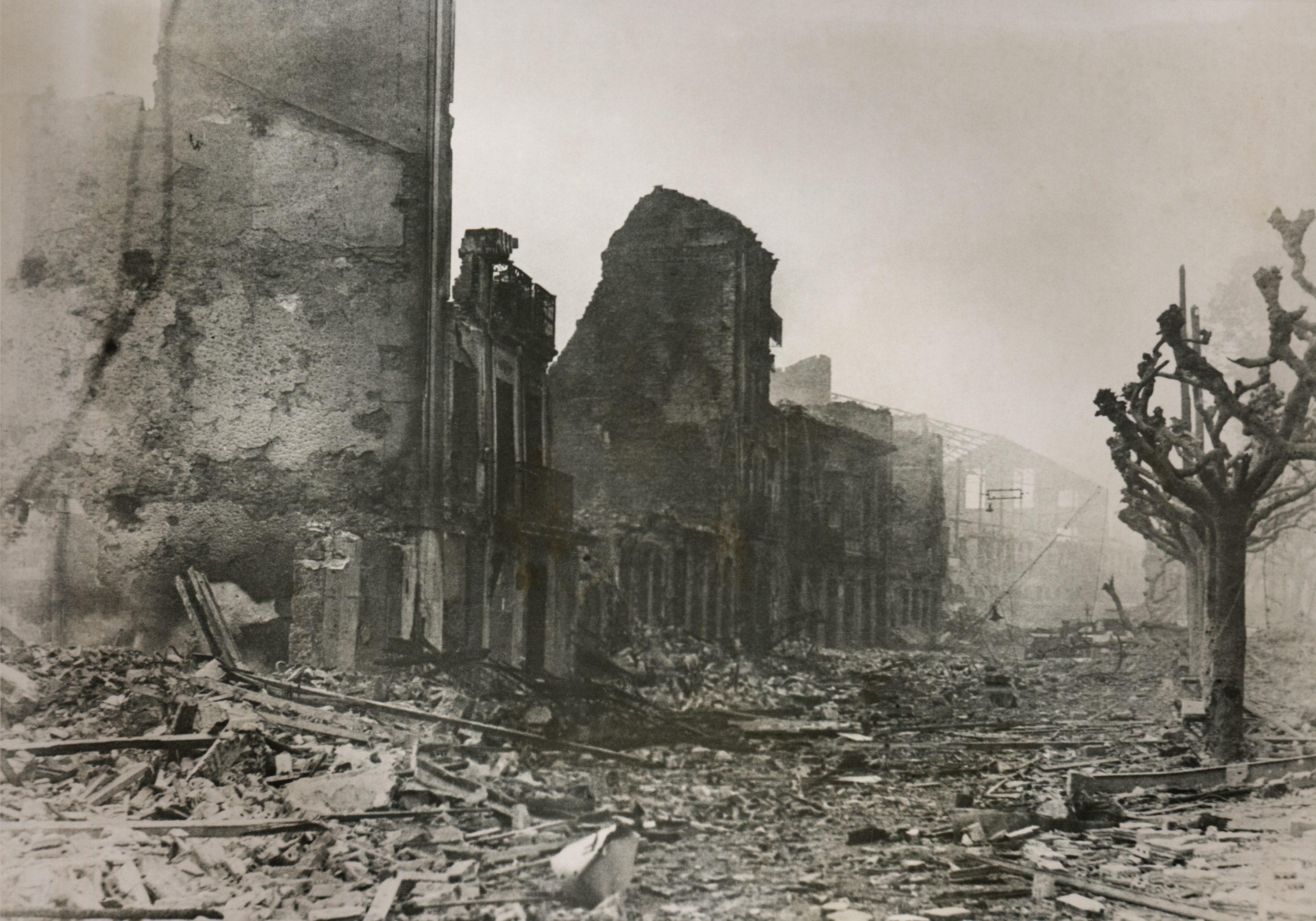Spanish Civil War was a bitter, bloody conflict that took place from 1936 to 1939. It was fought between the forces of Spain’s democratically elected, liberal government and conservative rebels. The war cost the lives of hundreds of thousands of Spaniards and set the stage for a dictatorship that lasted more than 35 years.

The conservative or right-wing forces that fought against the government were known as Nationalists. They included military leaders, segments of the Roman Catholic Church, groups that wanted Spain to become a monarchy again, and fascists. The fascists were members of a political party called the Falange Española (Spanish Phalanx). Like similar groups in Germany and Italy, the fascists wanted to set up a dictatorship.

The forces that fought on the side of the government were known as Republicans. They included a variety of liberal or left-wing groups, such as socialists, Communists, and anarchists (those who believe people should live without government).
Much of the world viewed the Spanish Civil War as a contest between democracy and fascism. It became a major source of concern for many nations, which believed that the outcome could determine the balance of power in Europe. Many people who felt strongly about the war held fund-raising rallies and publicized the international issues at stake in Spain’s domestic conflict.
Background to the war.
From 1923 to 1930, General Miguel Primo ruled Spain with the power of a dictator. King Alfonso XIII supported his government. By the end of Primo’s time in power, the movement for a republican form of government had gained strength in Spain. Supporters of the movement included liberals, socialists, and other people who did not want a monarchy. The strength of popular support forced Alfonso to allow free elections. In April 1931, the people voted overwhelmingly for republican candidates in city elections. Following the elections, Alfonso left the country, though he refused to give up his claim to the throne. Republican leaders then took control of the government and established what became known as the Second Republic.
The left-wing alliance of republicans and socialists that ruled Spain between 1931 and 1933 attempted to transform Spain’s social, economic, and political institutions. Some policies, including certain land reforms and the establishment of an eight-hour work day, threatened the upper classes who owned Spain’s land and industries. The government also tried to reduce the long-standing influence of the Roman Catholic Church in Spanish society and politics. Furthermore, the government adopted controversial measures aimed at reforming the armed forces.
These reforms created opposition to the government among increasing numbers of Spaniards, especially conservatives. In parliamentary elections held in 1933, an alliance of moderate and right-wing parties gained control of the government. The new government tried to reverse the progressive reforms of the earlier administration.
Elections held in February 1936 returned the liberals to power in an alliance of left-wing parties known as the Popular Front. In the late spring, a series of strikes, violent public demonstrations, and political assassinations caused most Spaniards to lose faith in the Popular Front.
Rebellion leads to civil war.
On July 17, 1936, Spanish army units stationed in Morocco launched a rebellion against the Spanish government. The revolt soon spread to Spain itself. The rebels hoped to overthrow the government quickly and restore order in Spain. But Republican forces took up arms against the military. Within four days after the start of the uprising, the rebels controlled about a third of Spain. The Republicans controlled Spain’s industrial centers and most of its densely populated towns and cities, including the capital, Madrid.
On both sides, a wave of terror and repression followed the chaos and confusion of the military uprising. The Nationalists shot thousands of workers and Republican supporters living in areas under their control. In the Republican zone, thousands of civilians were executed by working-class groups fearful of a reaction from rebel supporters.
In some areas held by Republicans, workers belonging to anarchist and other left-wing organizations dismantled existing government institutions. They replaced them with agricultural and industrial collectives—that is, groups jointly owned by their workers—and with bodies known as people’s committees that intended to rule on behalf of the working classes.
In late July 1936, the Nationalists set up a government in Burgos called the Junta de Defensa Nacional (Council of National Defense). In September, this group chose Francisco Franco to serve as both commander-in-chief of the armed forces and head of the Nationalist government. Franco and his advisers based the new government on fascist and conservative principles and created a prominent role in the government for the Roman Catholic Church. By the end of 1937, all the forces on the Nationalist side had merged into a state system under Franco’s leadership.
Foreign assistance.
In August 1936, France, Germany, Italy, the United Kingdom, and other European countries agreed not to intervene in the war. The French and British in particular feared that interference by other countries in the Spanish conflict could cause the war to spread to the rest of Europe.
As a result of the agreement, the United Kingdom and France—both supporters of the Republican government—did not provide it with aid. However, Germany’s Nazi government and Italy’s Fascist government both violated the agreement. Germany provided military aid to the Nationalists in exchange for certain mining rights. Italy supplied military equipment and troops to help Franco’s army.
The Soviet Union sent the Republicans food, clothing, and military equipment in exchange for most of Spain’s gold reserves. They also sent some police and military personnel. The Soviet-led organization known as the Comintern recruited volunteers from around the world to fight for the Republicans in groups called the International Brigades.
Progress of the war.
Early in the war, the Nationalists demonstrated superior military strength. By the first week of November 1936, rebel troops were closing in on Madrid, hoping to occupy the capital quickly. The determined resistance of the city’s population, supported by newly organized units of the International Brigades and Republican troops, stopped the Nationalist advance. The Republicans also defeated the Nationalists at the Jarama River near Madrid in February 1937 and at Guadalajara in March. But they lost the coastal city of Málaga to the Nationalists on February 8.
With the Madrid front stalled, Franco decided to launch a major offensive in the north. As part of this operation, on April 26, 1937, bombers of the German Condor Legion attacked the small market town of Guernica. They destroyed much of the town center and killed over 1,500 civilians, according to most estimates. News of the bombing generated a storm of international protests and demonstrations, and the incident became known as a symbol of fascist brutality. The Spanish painter Pablo Picasso captured the terror of the bombing in his masterpiece Guernica.

The Nationalists continued their northern assault. The city of Bilbao fell in June. A few months later, the Nationalists conquered the northern coastal areas and industrial regions that had been under Republican control. A major Nationalist offensive launched in the region of Aragon in March 1938 led farther into Republican territory. Franco’s army pushed east through the region and reached the Mediterranean Sea by mid-April, cutting the Republican-controlled zone in two.
Franco’s advance on Valencia, to the south, was interrupted by the Republican army’s last major offensive, the Battle of the Ebro. This battle, fought from July to November 1938, was the longest of the war. Despite early Republican gains, the Nationalists eventually halted the attack. The Republican defeat paved the way for the Nationalists’ march on Catalonia in the northeast. By the end of January 1939, most of the region, including Barcelona, was in Nationalist hands. Republican troops and their civilian supporters retreated toward the Spanish-French frontier.
Republican forces were plagued by disagreements among themselves throughout the war. By 1939, internal political disputes had split the Republicans into two warring groups. The government of Juan Negrin, who had come to power in 1937, wanted to continue fighting. But an alliance of left-wing parties considered further resistance useless. In March, this alliance set up its own government in Madrid. Shortly afterward, Negrin’s government collapsed.
As street fighting broke out between pro- and anti-Communist forces in Madrid and elsewhere, representatives of the new government sought in vain to negotiate a surrender with the Nationalists. On March 28, Franco’s troops began entering the capital. The remaining Republican forces throughout Spain surrendered, and Franco announced on April 1 that the war was over.
Results of the war.
The Spanish Civil War resulted in widespread destruction. Estimates of the numbers of people killed during the conflict vary. Many experts estimate that from 600,000 to 800,000 people died as a result of the war, including deaths caused by combat, bombing, execution, and starvation.
Following the war, Franco established a harsh right-wing dictatorship. He had thousands of Republican supporters executed and outlawed all political parties but his own. Spain did not return to democracy until after Franco’s death in 1975.
